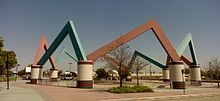
The Pacific Electric Railway Company, nicknamed the Red Cars, was a privately owned mass transit system in Southern California consisting of electrically powered streetcars, interurban cars, and buses and was the largest electric railway system in the world in the 1920s. Organized around the city centers of Los Angeles and San Bernardino, it connected cities in Los Angeles County, Orange County, San Bernardino County and Riverside County.

The Los Angeles County Metropolitan Transportation Authority (LACMTA), commonly branded as Metro, LA Metro, and L.A. Metro, is the state agency that plans, operates, and coordinates funding for most of the transportation system in Los Angeles County. The agency directly operates a large transit system that includes bus, light rail, heavy rail (subway), and bus rapid transit services; and provides funding for transit it does not operate, including Metrolink commuter rail, municipal bus operators and paratransit services. Metro also provides funding and directs planning for railroad and highway projects within Los Angeles County. In 2021, the system had a total ridership of 227,718,700 and had a ridership of 781,800 per weekday as of the second quarter of 2022.

The San Bernardino Line is a Metrolink line running between Downtown Los Angeles east through the San Gabriel Valley and the Inland Empire to San Bernardino, with express service to Redlands. It is one of the three initial lines on the original Metrolink system.
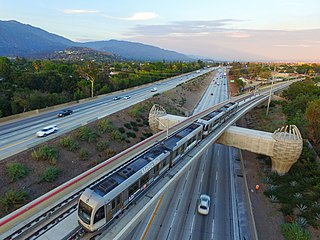
The L Line is a 31-mile (50 km) light rail line running from Azusa to East Los Angeles via Downtown Los Angeles serving several attractions, including Little Tokyo, Union Station, the Southwest Museum, Chinatown, and the shops of Old Pasadena. The line, one of seven in the Metro Rail system, entered service in 2003 and is operated by the Los Angeles County Metropolitan Transportation Authority (Metro). The L Line serves 26 stations.

Claremont is a passenger rail and bus station in Claremont, California, United States. It is served by Metrolink's San Bernardino Line which runs from Los Angeles Union Station to San Bernardino-Downtown, with some trains formerly continuing to Riverside on weekends. The Mission Revival-Spanish Colonial Revival style station is listed on the U.S. National Register of Historic Places as Atchison, Topeka and Santa Fe Railroad Station.

The Regional Connector Transit Project is a 1.9-mile (3.1 km) light rail tunnel under construction for the Los Angeles Metro Rail system in Downtown Los Angeles. It is designed to connect the A Line and E Line, which currently end at 7th Street/Metro Center station, to the existing L Line and Union Station. When completed, the project will provide a one-seat ride into the core of Downtown for passengers on those lines who currently need to transfer, and it will reduce or eliminate transfers for many passengers traveling across the region via Downtown.
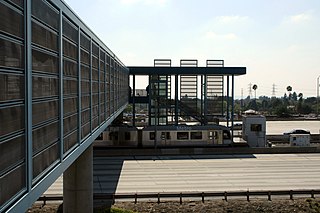
Sierra Madre Villa station is a light rail station on the L Line of the Los Angeles Metro Rail system. It is located in the median of Interstate 210, at Sierra Madre Villa Avenue, after which the station is named, in Pasadena, California. The light rail station opened on July 26, 2003, as the northern terminus of the original Gold Line, then known as the "Pasadena Metro Blue Line" project. This station and all the other original and Foothill Extension stations will be part of the A Line upon completion of the Regional Connector project in 2023.
The Pasadena Subdivision is the remnant branch line of the former Atchison, Topeka & Santa Fe Railway (AT&SF) Los Angeles Second District. The line currently branches off of the Metrolink San Bernardino line at CP Cambridge in Claremont. The line follows a generally east–west alignment, passed through the cities of Claremont, Pomona, La Verne, San Dimas, Glendora, and Azusa before coming to a truncated end in Irwindale. For most of its length it shares the corridor with the Metro L Line. Recent construction, known as the Foothill Gold Line Extension Phase 2B, as seen the tracks out of service west of San Dimas for most of 2021.

Montclair Transcenter is an intermodal transit center located at 5091 Richton Street in Montclair, California. It is located between Central and Monte Vista Avenues on Richton Street just north of the Montclair Plaza shopping center.

Arcadia station is an at-grade light rail station on the L Line of the Los Angeles Metro Rail system. It is located at the intersection of 1st Avenue and Santa Clara Street in Arcadia, California, after which the station is named.
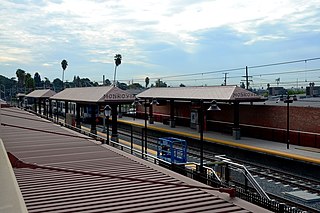
Monrovia is an at-grade light rail station on the L Line of the Los Angeles Metro Rail system. It is located at the intersection of Duarte Road and Myrtle Avenue in Monrovia, California, after which the station is named.

Irwindale station is an at-grade light rail station on the L Line of the Los Angeles Metro Rail system. It is located at the intersection of Irwindale Avenue and Avenida Padilla in Irwindale, California, after which the station is named.

Azusa Downtown station is an at-grade light rail station on the L Line of the Los Angeles Metro Rail system. It is located on Alameda Avenue, a block north of Foothill Boulevard, in Downtown Azusa, after which the station is named.

APU/Citrus College station is an at-grade light rail station on the L Line of the Los Angeles Metro Rail system. It is located between Palm Drive and Citrus Avenue, a block north of Foothill Boulevard, in Azusa, California. It is named after the nearby Azusa Pacific University (APU) and Citrus College.

The Los Angeles and San Gabriel Valley Railroad was a railroad founded on Sept. 5, 1883, by James F. Crank with the goal of bringing a rail line to Pasadena from downtown Los Angeles. Los Angeles and San Gabriel Valley Railroad was sold and consolidated on May 20, 1887 into the California Central Railway. In 1889 this was consolidated into Southern California Railway Company. On Jan. 17, 1906 Southern California Railway was sold to the Atchison, Topeka and Santa Fe Railway and called the Pasadena Subdivision. The main line closed in 1994. The railroad later reopened as the MTA Gold Line Light Rail service in July 2003.

The California Central Railway was incorporated on April 23, 1887, with headquarters in San Bernardino, California. George O. Manchester was the President of the corporation.
The history of the Los Angeles Metro Rail and Busway system begins in the early 1970s, when the traffic-choked region began planning a rapid transit system. The first dedicated busway opened along the 10 freeway in 1973, and the region's first light rail line, the Blue Line opened in 1990. Today the system includes over 160 miles (260 km) of heavy rail, light rail, and bus rapid transit lines, with multiple new lines under construction as of 2019.
Glendora is an under-construction light rail station in the Los Angeles County Metro Rail system. The station is located near the intersection of South Vermont Avenue and Ada Avenue along the Pasadena Subdivision right of way in Glendora, California. It will be served by the A Line. It is currently under construction as part of the Gold Line Foothill Extension and is slated to open in 2025.
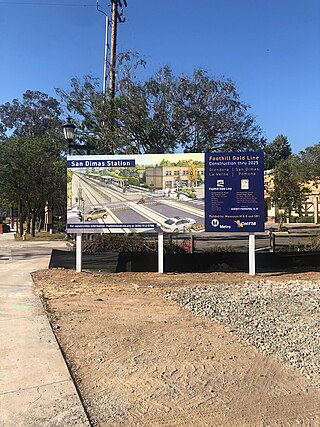
San Dimas is an under-construction light rail station in the Los Angeles County Metro Rail system. The station is located on San Dimas Avenue near its intersection with Bonita Avenue along the Pasadena Subdivision right of way in San Dimas, California. It will be served by the A Line. It is currently under construction as part of the Gold Line Foothill Extension and is slated to open in 2025.
La Verne is an under-construction light rail station in the Los Angeles County Metro Rail system. It is currently under construction as part of the Gold Line Foothill Extension and is slated to open in 2025. It will be served by the A Line.


